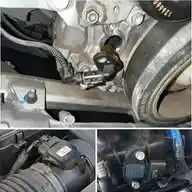
AUTOMOTIVE ENGINEERING
February 9, 2025 at 10:38 PM
Oil pumps are the unsung heroes of your engine’s lubrication system. Here’s a quick look at their essential function, how they work, and key tips to keep them running smoothly.
Role of Oil Pumps
Oil pumps circulate oil throughout the engine to cool, clean, and lubricate moving parts. They are typically driven by the crankshaft, creating suction to move oil from the pan through a filter and into the engine’s passages.
How Oil Pumps Work
Oil pumps don’t create pressure—they only move oil. Oil pressure is generated as the oil faces resistance in the engine’s passages. Smaller passages result in higher oil pressure, while larger ones lower it.
Factors Influencing Oil Pressure
• Bearing Clearances: Wider clearances reduce pressure but increase the oil flow.
• Oil Viscosity: Thicker oil creates more resistance, leading to higher pressure.
• Temperature: Hotter oil becomes thinner, lowering pressure.
Maintenance Tips
• Regular oil changes prevent blockages.
• Monitor oil pressure to detect issues early.
• Check for leaks to avoid oil loss.
• Use the manufacturer-recommended oil.
By following these tips, you can extend your engine’s lifespan and avoid costly repairs.
#oilpumps #enginehealth #lubrication #vehiclemaintenance #carcare #autorepair